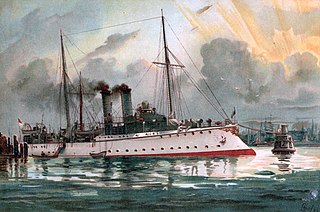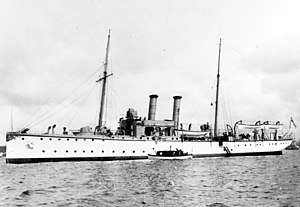
SMS Seeadler was an unprotected cruiser of the Bussard class, the third member of a class of six ships built by the German Kaiserliche Marine. Her sister ships included Bussard, the lead ship, along with Falke, Condor, Cormoran, and Geier. Seeadler was built at the Kaiserliche Werft in Danzig in late 1890, launched in February 1892, and commissioned in August of that year. Intended for colonial service, Seeadler was armed with a main battery of eight 10.5-centimeter (4.1 in) guns and had a top speed of 15.5 knots.

SMS Ägir was the second and final member of the Odin class of coastal defense ships built for the Imperial German Navy. She had one sister ship, Odin. Ägir was named for the norse god, and was built by the Kaiserliche Werft in Danzig between 1893 and 1896. She was armed with a main battery of three 24-centimeter (9.4 in) guns. She served in the German fleet throughout the 1890s and was rebuilt in 1901–1903. She served in the VI Battle Squadron after the outbreak of World War I in August 1914, but saw no action. Ägir was demobilized in 1915 and used as a tender thereafter. After the war, she was rebuilt as a merchant ship and served in this capacity until December 1929, when she was wrecked on the island of Gotland.

SMS Bremen was the lead ship of the seven-vessel Bremen class of light cruisers, built for the German Kaiserliche Marine in the early 1900s. She and her sister ships were ordered under the 1898 Naval Law that required new cruisers be built to replace obsolete vessels in the fleet. The design for the Bremen class was derived from the preceding Gazelle class, utilizing a larger hull that allowed for additional boilers that increased speed. Bremen was armed with a main battery of ten 10.5 cm (4.1 in) guns and had a top speed of 22 knots.

SMS Hansa was a protected cruiser of the Victoria Louise-class cruiser, built for the German Imperial Navy in the 1890s, along with her sister ships Victoria Louise, Hertha, Vineta, and Freya. Hansa was laid down at the AG Vulcan shipyard in Stettin in 1896, launched in March 1898, and commissioned into the Navy in April 1899. The ship was armed with a battery of two 21 cm guns and eight 15 cm guns and had a top speed of 19 knots.

SMS Vineta was a protected cruiser of the Victoria Louise class, built for the German Imperial Navy in the 1890s. Vineta was laid down at the AG Vulcan shipyard in 1895, launched in April 1897, and commissioned into the Navy in July 1898. The ship, named for the semi-legendary medieval town of Vineta, was armed with a battery of two 21 cm guns and eight 15 cm guns and had a top speed of 19 knots.

SM U-21 was a U-boat built for the Imperial German Navy shortly before World War I. The third of four Type U-19-class submarines, these were the first U-boats in German service to be equipped with diesel engines. U-21 was built between 1911 and October 1913 at the Kaiserliche Werft in Danzig. She was armed with four torpedo tubes and a single deck gun; a second gun was added during her career.

SMS Gefion was an unprotected cruiser of the German Kaiserliche Marine, the last ship of the type built in Germany. She was laid down in March 1892, launched in March 1893, and completed in June 1895 after lengthy trials and repairs. The cruiser was named after the earlier sail frigate Gefion, which had been named for the goddess Gefjon of Norse mythology. Intended for service in the German colonial empire and as a fleet scout, Gefion was armed with a main battery of ten 10.5-centimeter (4.1 in) guns, had a top speed in excess of 19.5 knots, and could steam for 3,500 nautical miles, the longest range of any German warship at the time. Nevertheless, the conflicting requirements necessary for a fleet scout and an overseas cruiser produced an unsuccessful design, and Gefion was rapidly replaced in both roles by the newer Gazelle class of light cruisers.

SMS Odin was the lead ship of her class of coastal defense ships built for the Imperial German Navy. She had one sister ship, Ägir. Odin, named for the eponymous Norse god, was built by the Kaiserliche Werft in Danzig between 1893 and 1896, and was armed with a main battery of three 24-centimeter (9.4 in) guns. She served in the German fleet throughout the 1890s and was rebuilt in 1901–1903. She served in the VI Battle Squadron after the outbreak of World War I in August 1914, but saw no action. Odin was demobilized in 1915 and used as a tender thereafter. After the war, she was rebuilt as a merchant ship and served in this capacity until 1935, when she was broken up for scrap.

SMS Danzig was a light cruiser of the Imperial German Navy. Named for the city of Danzig, she was the seventh and last ship of the Bremen class. She was begun by the Imperial Dockyard in her namesake city in 1904, launched on 23 September 1905 and commissioned on 1 December 1907. Armed with a main battery of ten 10.5 cm (4.1 in) guns and two 45 cm (18 in) torpedo tubes, Danzig was capable of a top speed of 22 knots.

SMS Berlin was the second member of the seven-vessel Bremen class of light cruisers, built for the German Kaiserliche Marine in the early 1900s. She and her sister ships were ordered under the 1898 Naval Law that required new cruisers be built to replace obsolete vessels in the fleet. The design for the Bremen class was derived from the preceding Gazelle class, utilizing a larger hull that allowed for additional boilers that increased speed. Named for the German capital of Berlin, the ship was armed with a main battery of ten 10.5 cm (4.1 in) guns and had a top speed of 22 knots.
The Markomannia incident was a conflict between Haitian rebels and the German Empire in 1902, sparked by the boarding of the Hamburg steamer Markomannia by rebel naval forces.

SMS Falke was an unprotected cruiser of the Bussard class, built for the Imperial German Navy. She was the second member of the class of six vessels. The cruiser was laid down in 1890, launched in April 1891, and commissioned into the fleet in September of that month. Designed for overseas service, she carried a main battery of eight 10.5-centimeter (4.1 in) guns and had a top speed of 15.5 knots.

SMS Cormoran was an unprotected cruiser of the Bussard class, the fifth member of a class of six ships. She was built for the Imperial German Navy for overseas duty. The cruiser's keel was laid down in Danzig in 1890; she was launched in May 1892 and commissioned in July 1893. Cormoran was armed with a main battery of eight 10.5-centimeter (4.1 in) guns, and could steam at a speed of 15.5 knots.

SMS Schwalbe was an unprotected cruiser built for the German Kaiserliche Marine, the lead ship of the Schwalbe class. She had one sister ship, Sperber. Schwalbe was built at the Kaiserliche Werft in Wilhelmshaven; her keel was laid down in April 1886 and her completed hull was launched in August 1887. She was commissioned for service in May 1888. Designed for colonial service, Schwalbe was armed with a main battery of eight 10.5-centimeter (4.1 in) guns and had a cruising radius of over 3,000 nautical miles ; she also had an auxiliary sailing rig to supplement her steam engines.

SMS Charlotte was a German screw corvette built for the Kaiserliche Marine in the 1880s, being laid down in April 1883, launched in September 1885, and commissioned in November 1886. The only vessel of her class, Charlotte was the last sailing warship built for the German navy. She was armed with a battery of eighteen 15 cm (5.9 in) guns.

SMS Iltis was the lead ship of the Iltis class of gunboats built for the German Kaiserliche Marine in the late 1890s and early 1900s. Other ships of the class are SMS Luchs, SMS Tiger, SMS Eber, SMS Jaguar, and SMS Panther.

SMS Luchs was the fourth member of the Iltis class of gunboats built for the German Kaiserliche Marine in the late 1890s and early 1900s. Other ships of the class are SMS Iltis, SMS Tiger, SMS Eber, SMS Jaguar and SMS Panther.

SMS Tiger was the third member of the Iltis class of gunboats built for the German Kaiserliche Marine in the late 1890s and early 1900s. Other ships of the class were SMS Iltis, SMS Luchs, SMS Eber, SMS Jaguar and SMS Panther.

SMS Arcona was a member of the Carola class of steam corvettes built for the German Kaiserliche Marine in the 1880s. Intended for service in the German colonial empire, the ship was designed with a combination of steam and sail power for extended range, and was equipped with a battery of ten 15-centimeter (5.9 in) guns. Arcona was laid down at the Kaiserliche Werft in Danzig in 1881, she was launched in May 1885, and she was completed in December 1886.

SMS Freya was a steam corvette of the German Kaiserliche Marine. She was the third member of the Ariadne class, which included two other ships, Ariadne and Luise. Ordered as part of a large naval expansion program after the Austro-Prussian War, she was laid down in 1872 after the Franco-Prussian War. She was launched in December 1874 and completed in October 1876. Freya was built to a different design than her sisters, being longer and carrying a heavier battery of twelve guns.




















